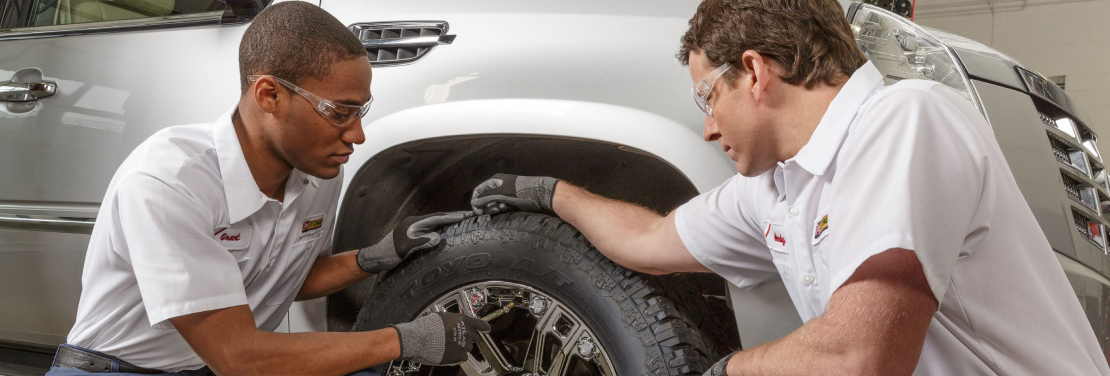Specialist Morris Tire and Alignment: Enhance Your Lorry's Efficiency
Specialist Morris Tire and Alignment: Enhance Your Lorry's Efficiency
Blog Article
Tire Service: The Influence of Weather
When it comes to guaranteeing ideal efficiency and security on the road, comprehending the impact of weather conditions on tire solution is crucial. In this conversation, we will check out the elaborate connection between weather condition problems and tire service, shedding light on the importance of weather-specific tire maintenance techniques and considerations.
Heat and Tire Performance
When exposed to high temperatures, tires experience adjustments in efficiency that can substantially influence automobile security and handling. The warm produced from prolonged driving or heat problems creates the tire rubber to soften, bring about lowered walk life and enhanced wear. As the rubber becomes softer, the tire's grasp on the roadway reduces, impacting braking ranges and overall traction. In severe situations, excessive warmth can also cause tire blowouts, posturing a severe security risk to the lorry and its occupants.
In addition, high temperatures can speed up the procedure of tire aging, triggering the rubber to deteriorate much more swiftly. To minimize the results of warmth on tire performance, motorists need to routinely inspect their tire stress, rotate tires to guarantee also put on, and check for any signs of damages.
Cold Climate Impacts
Winter conditions can have a considerable effect on tire efficiency and safety and security. As temperature levels decline, tire rubber can set, leading to reduced grip on icy or snow-covered roads. In winter, tires may additionally shed air pressure more quickly, which can affect handling and gas effectiveness. Furthermore, cool temperatures can cause tire sidewalls to stiffen, enhancing the risk of damages from potholes or other road dangers.
To alleviate the results of winter on tires, it is important to frequently examine tire pressure and inflate them to the manufacturer's recommended degrees. Making use of winter or all-season tires designed for cool weather conditions can likewise improve traction and grip on icy or snowy roadways - mopar tire service specials. Proper tire upkeep, consisting of normal examinations for wear and damages, ends up being much more important throughout cooler months to guarantee optimum performance and safety and security
Rainy Issues Influence
Tires with worn-out footsteps are a lot more vulnerable to hydroplaning, where a layer of water constructs up between the road and the tire surface area, leading to loss of traction. To fight this, motorists must regularly examine their tires for ample walk depth and take into consideration spending in tires particularly created for wet problems.

Snow and Tire Security
Snow-covered roadways position unique obstacles for drivers, emphasizing the relevance of proper tire selection and upkeep. When driving in snowy problems, having the appropriate tires can make a substantial difference in safety and performance. Winter season tires are developed with unique rubber compounds and walk patterns to provide far better traction on snow and ice compared to all-season tires. The deeper footsteps and sipes of winter season tires aid hold the road much better, decreasing the danger of moving and slipping.
In addition to making use of winter season tires, it is critical to ensure they are properly pumped up. Cold weather condition can create tire pressure to drop, affecting grip and handling (tires morris il). Frequently examining and preserving the proper tire pressure is vital for ideal performance in snowy conditions

Weather-Related Tire Maintenance
When faced with different climate condition, appropriate tire upkeep ends up being an important element of vehicle safety and efficiency. Weather-related tire upkeep incorporates a variety of methods targeted at making certain optimum tire feature and longevity in different weather condition circumstances. One crucial element of weather-related tire upkeep is tire stress policy. Rising and fall temperatures can cause tire stress to vary, affecting traction and fuel performance. Consistently changing and examining tire stress according to maker recommendations is necessary for risk-free driving in changing weather problems. Furthermore, tire walk depth plays a significant function in managing different weather components. Tires with ample walk depth provide far better grasp on wet or icy roads, reducing the threat of hydroplaning or skidding. When step wear reaches a particular depth is important for maintaining traction and stability in negative climate, evaluating tire step on look what i found a regular basis and changing tires. By prioritizing weather-related tire maintenance, drivers can improve safety and security, improve automobile performance, and lengthen the lifespan of their tires.
Verdict
In verdict, weather problems have a considerable impact on tire efficiency and safety (morris tire and alignment). From warm affecting tire pressure and wear to cold climate minimizing traction, it is crucial to think about the weather condition when maintaining and using tires.
In this discussion, we will explore the detailed connection between weather conditions and tire solution, shedding light on the significance of weather-specific tire maintenance methods and considerations.

Report this page